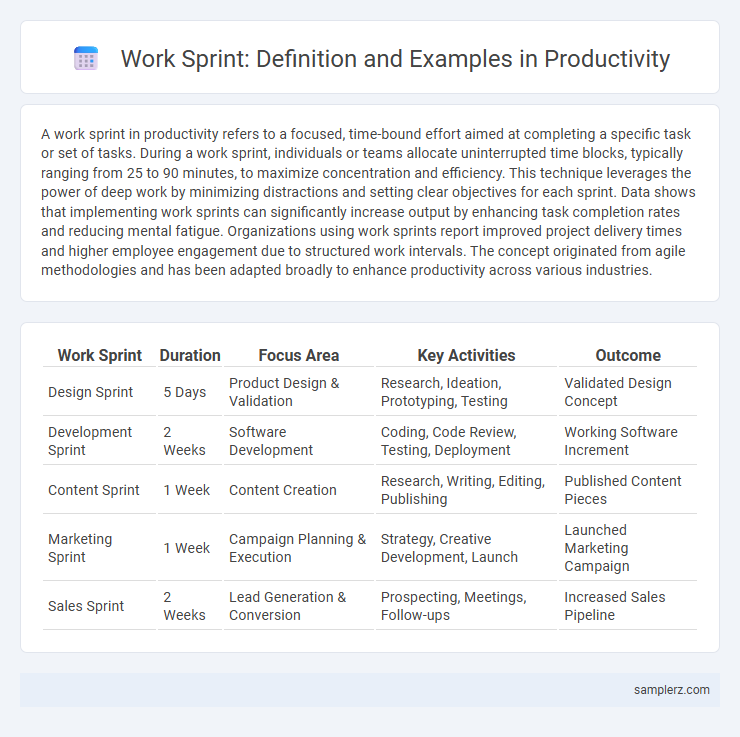A work sprint in productivity refers to a focused, time-bound effort aimed at completing a specific task or set of tasks. During a work sprint, individuals or teams allocate uninterrupted time blocks, typically ranging from 25 to 90 minutes, to maximize concentration and efficiency. This technique leverages the power of deep work by minimizing distractions and setting clear objectives for each sprint. Data shows that implementing work sprints can significantly increase output by enhancing task completion rates and reducing mental fatigue. Organizations using work sprints report improved project delivery times and higher employee engagement due to structured work intervals. The concept originated from agile methodologies and has been adapted broadly to enhance productivity across various industries.
Table of Comparison
| Work Sprint | Duration | Focus Area | Key Activities | Outcome |
|---|---|---|---|---|
| Design Sprint | 5 Days | Product Design & Validation | Research, Ideation, Prototyping, Testing | Validated Design Concept |
| Development Sprint | 2 Weeks | Software Development | Coding, Code Review, Testing, Deployment | Working Software Increment |
| Content Sprint | 1 Week | Content Creation | Research, Writing, Editing, Publishing | Published Content Pieces |
| Marketing Sprint | 1 Week | Campaign Planning & Execution | Strategy, Creative Development, Launch | Launched Marketing Campaign |
| Sales Sprint | 2 Weeks | Lead Generation & Conversion | Prospecting, Meetings, Follow-ups | Increased Sales Pipeline |
What Is a Work Sprint in Productivity?
A work sprint in productivity is a focused, time-boxed period dedicated to completing specific tasks or projects with maximum efficiency. This method leverages intense concentration and minimizes distractions to accelerate progress and enhance output quality. By setting clear goals and limiting task scope, work sprints boost overall productivity and help maintain momentum on complex or lengthy assignments.
Key Elements of a Successful Productivity Sprint
A successful work sprint in productivity hinges on clear goal setting, time-boxed intervals, and focused task execution to maximize output within a short period. Prioritizing tasks based on impact and eliminating distractions ensures sustained concentration and efficient progress. Regular breaks and sprint reviews help maintain energy levels and facilitate continuous improvement throughout the sprint cycle.
Step-by-Step Example of a Work Sprint
A work sprint in productivity typically involves setting a clear, focused goal to complete within a short, defined time frame, such as 25 to 60 minutes. The process begins by identifying a specific task, eliminating distractions, and dedicating uninterrupted time solely to that task to maximize efficiency. Upon completion, a brief review and a short break help sustain motivation and prepare for the next sprint cycle.
Work Sprint vs. Traditional Workflow: A Comparison
Work sprints in productivity emphasize focused, time-boxed efforts, typically lasting 1-4 weeks, to deliver specific outcomes, contrasting with traditional workflows that often rely on longer, less structured timelines. This approach boosts efficiency by minimizing multitasking and promoting clear goal-setting, resulting in faster feedback and iterative improvements. Metrics from agile teams show a 25-35% increase in task completion rates during work sprints versus conventional methods.
Setting Goals for a Productive Work Sprint
Setting clear, measurable goals is essential for a productive work sprint, as it provides direction and focus for the team. Breaking larger tasks into specific, time-bound objectives enhances accountability and progress tracking. Utilizing project management tools to outline these goals ensures alignment and efficient collaboration throughout the sprint.
Tools and Techniques for Effective Work Sprints
Work sprints in productivity leverage tools like Trello and Asana for task management and time tracking apps such as Toggl to monitor focused work intervals. Techniques including the Pomodoro method and time blocking enhance concentration and minimize distractions during sprints. Effective work sprints combine clear goal setting with digital tools to maximize output within short, dedicated periods.
Real-Life Examples of Work Sprints in the Workplace
Work sprints boost productivity by focusing teams on short, intense periods of task completion, such as a software development team coding a new app feature within a two-week sprint cycle. Marketing departments often use work sprints to rapidly create campaign content, enhancing collaboration and faster project turnover. Sales teams implement daily sprints to prioritize lead follow-ups, significantly increasing conversion rates and overall team efficiency.
Common Challenges During a Productivity Sprint
Common challenges during a work sprint include managing distractions, maintaining consistent focus, and avoiding burnout due to prolonged intense effort. Time estimation errors often lead to unrealistic goals, causing stress and reduced productivity. Effective sprint planning and regular breaks are essential strategies to overcome these obstacles and sustain high performance.
Measuring Results After a Work Sprint
Measuring results after a work sprint involves analyzing key performance indicators such as completed tasks, time spent, and quality of output to assess productivity effectively. Tracking metrics like velocity, task completion rate, and error frequency provides insights into team efficiency and areas for improvement. Data-driven evaluation ensures continuous progress and informed adjustments for future work sprints.
Tips for Integrating Work Sprints Into Your Routine
Work sprints enhance productivity by breaking tasks into focused, time-boxed intervals, typically 25 to 50 minutes, maximizing concentration and minimizing distractions. To integrate work sprints into your routine, prioritize tasks using the Eisenhower Matrix, set clear goals for each sprint, and utilize tools like Pomodoro timers or apps such as Focus Booster. Regularly review sprint outcomes to adjust durations and improve workflow efficiency, ensuring sustainable momentum and reduced burnout.

example of **work sprint** in **productivity** Infographic
 samplerz.com
samplerz.com